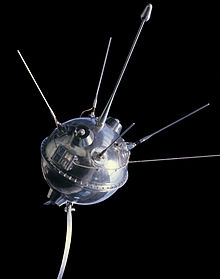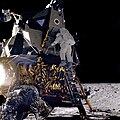月球1号
| 所属组织 | 苏联 |
|---|---|
| 主制造商 | 第一实验设计局(OKB-1) |
| 任务类型 | 月球撞击器 |
| 掠过对象 | 月球 |
| 掠过时间 | 1959年1月4日 |
| 环绕对象 | 太阳 |
| 绕轨圈数 | 43次 (截至2012年) |
| 发射时间 | 1959年1月2日 16:41:21 UTC |
| 发射手段 | 月球号运载火箭 |
| 运载火箭 | 8K72 |
| 发射地点 | 拜科努尔加加林启航处 |
| 任务时长 | 3日 |
| COSPAR ID | 1959-012A |
| SATCAT no. | 00112 |
| 质量 | 361千克(796英磅) |
| 轨道参数 | |
| 参考坐标系 | 日心 |
| 轨道类型 | 椭圆 |
| 半长轴 | 半长轴 |
| 离心率 | 0.14767 |
| 倾角 | 0.01° |
| 远拱点 | 1.315 AU |
| 近拱点 | 0.9766 AU |
| 周期 | 450 天 |
| 月球表面着陆 | |
| 着陆日期 | 1959年1月4日 |
| 着陆地点 | 着陆失败(距离月面5,995公里) |
月球1号(俄语:Луна-1),亦称梦(Мечта)[1]、E-1 4号和第一宇宙船[2],是苏联、也是人类发射成功的第一个星际探测器。它是一系列以“月球号”命名的探测器中的第一个成员。它是第一个接近月球的航天器[3],也是第一个围绕太阳公转的航天器。但是,月球1号原本却是一个月球撞击器,即其任务为撞向月球,但最终在6000多公里的上空掠过月球,并成为第一个脱离地球引力的航天器。[4]
构造
[编辑]
月球1号拥有一组无线电设备 ,其中包括一个跟踪发射器和遥测系统,以及五个用来研究月球和星际空间的仪器,包括一个磁强计、盖革计数器、闪烁计数器和微陨石探测器。[5]
发射月球1号所使用的火箭被称为月球号火箭。这实际上是卫星号火箭的一种改进型。[6]
发射
[编辑]月球1号是于1959年1月2日 16:41 GMT(当地时间 22:41 UTC+6)在拜科努尔加加林启航处由月球号运载火箭8K72运载升空。但是地面控制系统的故障导致火箭的点燃时间出现误差,因此月球1号只能于1959年1月4日在月球上空5,995公里处掠过。[7]月球1号在掠过月球表面后,随即离开地球轨道。这使它成为人类发射成功的第一个摆脱地球引力场的航天器。因此,苏联的科学家们便将之更名为“梦”,全因他们没想过航天器能够摆脱地球引力之余,还能够成为人造行星。[8]现在,月球1号仍然环绕着太阳公转,其轨道位于地球轨道与火星轨道之间,且截至2012年已环绕太阳43次。[9]
任务
[编辑]在月球1号发射之前,苏联航天机构已经进行了三次尝试向月球派遣航天器了,它们分别是月球1A号、月球1B号和月球1C号,全部以火箭升空期间爆炸告终。[10]在第一颗人造卫星发射成功不到一年之后就进而做这种难度更高的航天活动,这一方面是因为赫鲁晓夫基于与美国打宣传战的目的而鼓励这种太空竞赛[11],一方面也是由于苏联太空计划的总负责人科罗廖夫对自己开发的火箭的能力具有充分的信心。[12]
月球撞击
[编辑]月球1号原本被设计成撞向月球的航天器,并且计划将运载着两面苏联国徽金属锦旗运往月球。但是,因为火箭的点燃时间出现误差,因此月球1号在月球上空约6,000公里掠过,任务以失败告终。这个任务最终由月球2号完成。[13]
尽管如此,月球1号的失败却成为了人类航天的一大突破。月球1号先后成为了人类首个接近月球的航天器、首个脱离地球引力的航天器和首个围绕太阳公转的航天器。月球1号亦同时完成了很多额外的任务。[14]
太阳风测量
[编辑]在经过范艾伦辐射带时,月球1号的闪烁器让科学家发现外辐射带存在少量的高能粒子。这一发现向科学家们提供了关于地球辐射带和外层空间的新资讯。同时,月球1号也让科学家们发现月球其实没有磁场。科学家们亦透过月球1号首次对太阳风进行直接的观察和测量。[2][15][16]当时,月球1号分别在离地表2万–2.5万公里高空和10万–15万公里高空测量等离子体的密度,并得出两者的密度分别是每立方厘米700粒和每立方厘米300–400粒。而这也是人类首次与距离五十万公里的航天器进行无线电通信。[17]
钠释放实验
[编辑]月球1号曾进行了一个在太空释放气体钠的实验,目的是研究气体在太空中的特性。于1959年1月3日 00:56:20 UTC,月球1号在地球上空119,500千米(74,300英里)释放了1千克(2.2英磅)气体钠,并令到月球1号成为一个人造彗星。[17]这个拖着橙色尾巴的人造彗星能在释放气体后数分钟在印度洋上空可见,且罗斯卓波维·格涅维舍夫亦成功在基斯洛沃茨克附近的俄罗斯科学院主天文台拍摄人造彗星。[18]
最终命运
[编辑]月球1号的最终命运是成为了第一个人造行星,它围绕太阳公转,周期为450天。[9]
参考文献
[编辑]- ^ David Darling, The complete book of spaceflight: from Apollo 1 to zero gravity. John Wiley and Sons, 2003, p. 244. ISBN 978-0-471-05649-2
- ^ 2.0 2.1 Brian Harvey, Russian planetary exploration: history, development, legacy, prospects. Springer, 2007, p.26. ISBN 978-0-387-46343-8
- ^ CHRONOLOGY - Five key dates in the race to the moon. [2013-11-30]. (原始内容存档于2015-10-16).
- ^ Luna Mission - Lunar and Planetary Institute - USRA. [2013-11-30]. (原始内容存档于2021-02-25).
- ^ Luna 1 - the NSSDC! - NASA. [2013-11-30]. (原始内容存档于2017-06-26).
- ^ Boris Chertok, "Rakety i liudi: goriachie dni, kholodnoy voyny", Moscow, "Mashinostroenie", 2-nd edition, 1999. Section 2-7 互联网档案馆的存档,存档日期2008-08-03..
- ^ 1959: Luna 1 - Astrodene. [2013-11-30]. (原始内容存档于2021-01-18).
- ^ Cormack, Lesley B. A History of Science in Society: From Philosophy to Utility, Second Edition. University of Toronto Press. 15 March 2012: 342 [21 March 2012]. ISBN 978-1-4426-0446-9. (原始内容存档于2020-08-05).
- ^ 9.0 9.1 USSR - Luna 1 - Zarya. [2013-11-30]. (原始内容存档于2012-12-25).
- ^ Wade, Mark. Soyuz. Encyclopedia Astronautica. [26 July 2010]. (原始内容存档于2010年1月17日).
- ^ Tompson, William J., Khrushchev: A Political Life, St. Martin's Press, 1995, ISBN 978-0-312-12365-9 p.188.
- ^ Harford, James. Korolev: How One Man Masterminded the Soviet Drive to Beat America to the Moon. New York: Wiley, 1999. Print.
- ^ Soviet Missions to the Moon - the NSSDC! - NASA. [2013-11-30]. (原始内容存档于2009-09-04).
- ^ Soviet Craft - Luna 互联网档案馆的存档,存档日期2013-07-08.
- ^ David Darling, Internet Encyclopedia of Science.. [2013-11-30]. (原始内容存档于2016-10-07).
- ^ Luna 1. NASA National Space Science Data Center. [4 August 2007]. (原始内容存档于2007-03-11).
- ^ 17.0 17.1 Soviet Space Rocket. Yearbook of the Great Soviet Encyclopedia. Moscow: Sovetskaya Enciklopediya. 1959. ISSN 0523-9613. (原始内容存档于2008-01-18) (俄语).
- ^ Luna E-1 - Encyclopedia Astronautica 互联网档案馆的存档,存档日期2010-12-22.
参见
[编辑]
| |||||||||||||||||||||||||||||||
| |||||||||||||||||||||||||||||||||||||||||||||||||||||||
Text is available under the CC BY-SA 4.0 license; additional terms may apply.
Images, videos and audio are available under their respective licenses.



